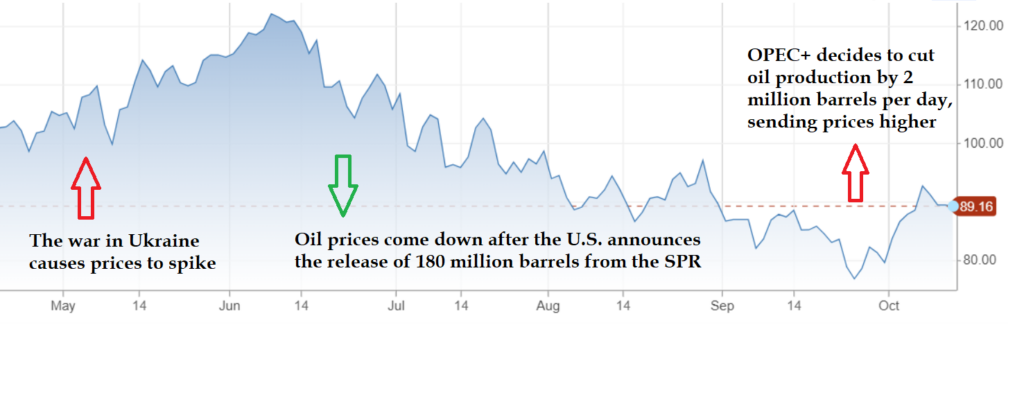After reaching record highs in June, gas prices fell by 25% by September. Now, gas prices are on the rise again. Why are gas prices going up? Blame supply and demand. However, there’s a bit more to the story this time around.
Production Cuts Push Crude Oil Prices Higher
In June, crude oil prices had climbed to $120 per barrel as the war in Ukraine complicated operations and oil exports for Russia, the world’s third-largest oil producer. In 2021, imports from Russia accounted for 8% of all U.S. petroleum imports. As Russia’s military invaded Ukraine, the United States decided to ban all Russian oil and gas imports.
Oil prices climbed, and the national average topped out at $5.01 for a gallon of gas. To relieve supply shortages, the U.S. decided to release 180 million barrels of crude oil from the nation’s Strategic Petroleum Reserves in July. Oil prices fell, and gas prices dropped at the quickest pace ever.
But gas prices are now more than twenty cents higher than September lows. As of the time of this writing, the national average price for a gallon of gasoline is $3.92. See today’s gas prices at AAA. With crude oil prices increasing almost daily, $4 gas prices are likely to return.

Why are gas prices going up? On October 5, the world’s largest oil cartel decided to cut oil production for no reason other than to prop up prices.
In early October, OPEC+ announced that it would cut daily oil output by 2 million barrels. Globally, roughly 80 million barrels of oil are produced each day, but the markets decided this is a lot more than a drop in the bucket.
Who Is OPEC+?

OPEC+ refers to the 13 nations in the Organization of Petroleum Exporting Countries (OPEC) and 11 non-OPEC partner countries. The OPEC+ group was created in 2016 with the stated goal of working together to adjust crude oil production to bring stability to the oil market. In other words, OPEC+ exists to keep global crude oil prices where they want them.
OPEC+ countries hold 90% of the world’s proven crude oil reserves. With such power of the market, they have the capability to disrupt or enhance the supply of crude oil. Global oil markets pay close attention to the actions of OPEC+.
The OPEC+ oil cartel consists of the following oil-producing nations.
OPEC core members:
Algeria, Angola, Equatorial Guinea, Gabon, Iran, Iraq, Kuwait, Libya, Nigeria, the Republic of the Congo, Saudi Arabia, the United Arab Emirates and Venezuela.
OPEC+ members:
Azerbaijan, Bahrain, Brunei, Equatorial Guinea, Kazakhstan, Russia, Mexico, Malaysia, South Sudan, Sudan and Oman
When Will Gas Prices Go Down?

In order for gas prices to go down, either oil supply will have to increase, or demand will have to decrease. With just one month before the Thanksgiving travel holiday, demand is likely to increase in the weeks ahead, driving prices towards $4 per gallon.
If oil demand follows pre-pandemic historical trends, we could see softening demand from January to April. Peak oil demand is historically during summer and holiday travel months, with weaker demand in the winter and spring. Unless the government and domestic producers can find a way to bring down prices before then, that might be the next time gas prices drop back below current levels.
The United States meets 65% of its oil demand through domestic production. Ten years ago, 40% of America’s oil consumption was supplied domestically. The U.S. is producing more oil than ever before, but it continues to export millions of barrels to other countries. Regulators are surely looking into how they could send more domestic oil to American refineries.
Here’s How to Save Money On Gas
We created a special resource to help drivers save money on fuel expenses. These are the top ways you can save on gas:
- Use phone apps to find the cheapest gas
- Don’t buy gas along the interstate
- Interstate Travel: Buy Gas in States with Lower Gas Taxes
- Find out which credit cards offer fuel points
- Use grocery store fuel points
See our full guide to maximizing fuel savings. You can save hundreds of dollars with a few simple tricks!
Right now is a tough time to be in the market for a new or used vehicle, but remember to consider fuel economy next time you’re shopping for a new ride. For the average commuter, the difference between 25 MPG and 45 MPG can be over $1,000 per year in fuel savings.
Thinking of going all-electric? These are the best electric cars on the market for under $50,000.













0 Comments